Why You Should Separate Your Transactional and Your Marketing Email Sending
Tuesday, March 4th, 2025A typical healthcare organization sends at least two distinct classes of email messages: business or transactional emails and marketing emails.
Transactonal email consists of all of the individual, personal messages sent by sales, support, billing and other departments to specific people. These messages are generally more time sensitive and it is very important that the recipients actually receive them. These messages should not be delayed by any kind of spam filtering software, if possible.
Marketing emails are messages sent in bulk to many people at once. Examples of marketing messages include company newsletters, new product offers, promotions and ads, status notices, etc. You will need HIPAA compliant email marketing for this if you are marketing into the healthcare market
Separating your transactional and marketing emails can help ensure they are reliably delivered. Using different email servers and maybe even a unique domain name can improve your email deliverability. This post will look at why.
Separate Transactional and Marketing Email to Improve Deliverability
Successful marketing includes building your brand reputation in the eyes of your current and would-be customers or patients. However, by its very nature, sending marketing email can damage the reputation of your email address, domain, and email servers. It doesn’t have to, but it can … and it can happen in unexpected ways.
Spam Complaints
- The larger your marketing mailing list is, the more people are on it who do not really want your email. This is a fact of email marketing, even if you abide by the CAN-SPAM Act and have an “opt-in” list.
- The more often you send email to your mailing lists, the more often these people will be annoyed by your email messages.
- Some of these annoyed people will complain that your email is “spam,” instead of using the unsubscribe link. This is because they are either too lazy to opt-out, annoyed by the message, don’t believe the opt-opt will work, or never even bothered to look to see if they could opt-out.
This all contributes to the generation of spam complaints. Receiving many spam complaints can cause email servers to start blocking your emails. This can be based on either your email content, your sending email address, or your sending email server IP address.
It is best to keep your complaint rate to a minimum by monitoring your complaint feed back loops, opting out anyone who complains and maintaining active mailing lists that contain only opted-in parties.
Spam Content
By its very nature, the types of email that fall into the bulk email marketing category share many common characteristics. Email filtering software is sophisticated and can often tell the difference between a marketing message and a business message. Sending many messages with spam-like qualities to a recipient server can result in your email being delayed, filtered, or blocked.
Spam-like content detection can be something as simple as the text of the required section of your email that indicates how to “opt-out.” Many legitimate messages can be classified as spam-like simply due to the nature of pattern recognition.
Email Delivery Throughput
Transactional email messages are classified as “transactional.” They are unique messages usually sent throughout the day to individuals. Marketing email messages are called “bulk” emails, meaning the same message is sent in large batches to multiple recipients in short time frames.
The sending of marketing messages can place a significant burden on your outbound email sending servers. Sending many messages within a short time frame can degrade performance and cause your business email to be delivered much more slowly if they are sharing the same outbound service.
Many marketing emails cannot be immediately delivered to the recipients and are placed in a queue to retry over time. For large marketing email lists (and especially in cases where your sending server is getting blacklisted) this can result in large email queues which slow down the delivery of both business and marketing email if sent from the same server.
Blacklisting
An all-too-common side effect of marketing email is having the sending email server blacklisted. When your server is blacklisted, by say yahoo.com, then all email to recipients at that domain will fail to be delivered. If you are sending transactional email through the same server as your marketing email then your transactional email to these same folks will also fail. This is the most critical reason why you should use separate servers for transactional and marketing email.
But how could you get blacklisted?
- If your mailing lists have bad email addresses on them. E.g. non-opt in, purchased, spam trap, spidered, or other addresses that you should never email.
- If your mailing addresses have lots of invalid email addresses on them. E.g. the list is very old and includes defunct addresses.
- Your email content is frequently flagged as spam-like.
It is true that the larger your list and the more you send, the more likely you are to get blacklisted, unless you are careful about managing your subscriber base.
Shared Email Services
If you share outbound email servers with other customers of your provider, then your sending can be impacted by their behavior. If they are sending spam and get the server blacklisted, then that affects your emails as well. The only thing that protects you in these cases is the policies of your email provider. Better yet, use a dedicated server from LuxSci and don’t share your email servers with anyone else.
Recommendations for Successful Emailing
In order to reliably deliver your business and marketing emails, we recommend:
- Using a different domain name in the “From” and “Reply” email address for your transactional and marketing emails. E.g. info@widget-wiz.net for your marketing email and info@widget-wiz.com for your business (e.g. sales) email. These can go back to the same person and same INBOX, but having different domains allows blocks on your marketing domain to not affect your business domain.
- Using good deliverability tactics and best practices for your marketing email messages.
- Sending your marketing email messages through email servers separate from your business email so that black lists and throughput issues do not affect your business email.
- Ensuring that your email provider has good policies and controls in place so that other customers do not affect your email’s deliverability.
- Can benefit from dedicated email server infrastructure that sends fully HIPAA compliant email
- Can use separate High Volume accounts for bulk email. These are sent from separate servers from our business email accounts and are designed for processing mass emails.
Want to learn more, contact us today!








